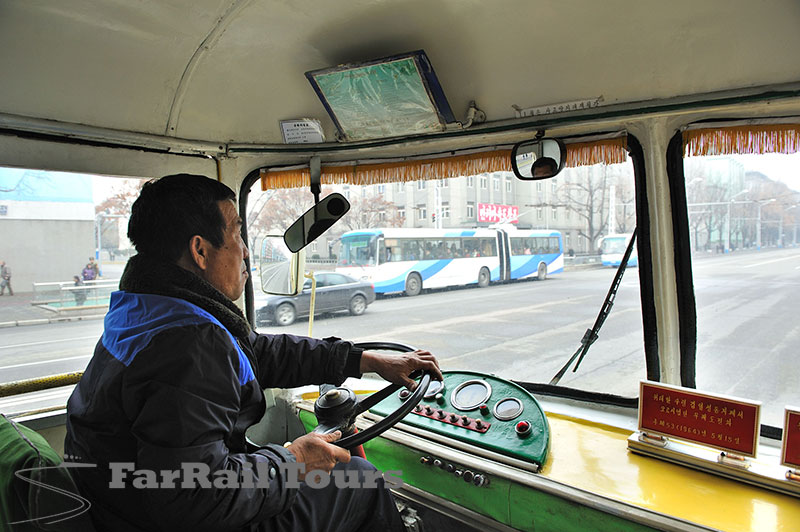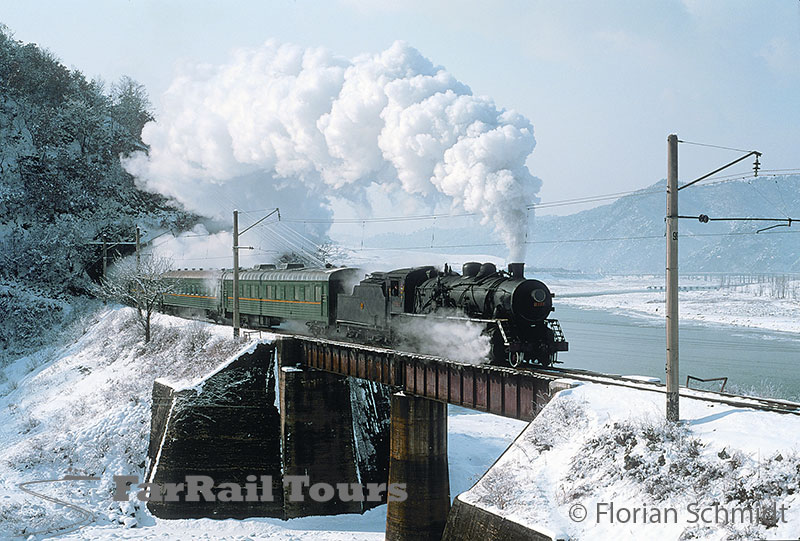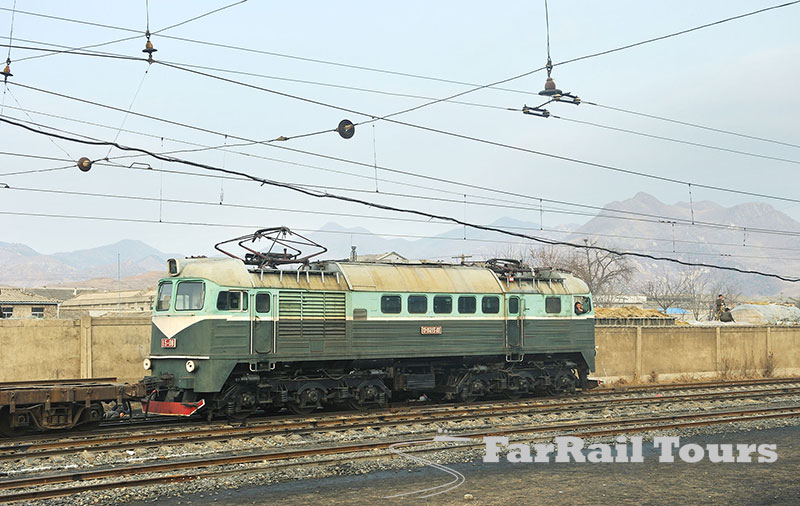

No tour to the DPRK has ever offered seven steam locomotives in use. That’s something just not possible since the state railway dropped the last fire in their last locomotive a decade ago.

On the rails, we’ll see the trams in
This tour was initiated, planned and organised together with Florian Schmidt from Singapore. Florian, as well as your tour leader Bernd, have been arranging FarRail’s successful North Korean ventures in the past and know most of the places we will be visiting, as well as the culture of our host country.

|
Date |
Itinerary |
|
16.02. |
Individual flight to Beijing |
|
17.02. |
Connecting flight to |
|
18.02. |
Flight from |
|
19.02. |
In the morning we’ll see four 2-6-2- steam locomotives outside of the Kim Chaek steel works in a small shunting yard. We are allowed to move the locos around by about 600 metres for some photographs in the shunting yard. Hotel in |
|
20.02. |
Morning: steam charter with a 2-8-2- Mika from Afternoon visit to the monument of the leaders of the country. Hotel in |
|
21.02. |
Continue by charter bus to Orang. On the way we may see and photograph a regular train passing by. Charter flight back to |
|
22.02. |
|
|
23.02. |
Early morning bus ride to Kujang, packed breakfast. Charter train with a 2-8-2 Mika from Kujang to Hyangsan (electrified line) with a few photo runpasts. Here we’ll visit the Buddhist Pohyon temple. Lunch in the marvellous Hyangsan hotel, later return to Koryo Hotel in |
|
24.02. |
Another early morning start will bring us to the West Sea barrage near Nampho. Steam charter train from the West Sea Barrage to Cholgwang where we’ll probably arrive by noon. This is the first train where we are almost sure to be able to offer some decent runpasts with good photographic opportunities. Lunch at the Ryonggang Hotspa Guesthouse, afternoon return to |
|
25.02. |
Charter bus to Songrim to visit three diesel locomotives, one Hungarian, one Chinese and one Korean-built. Afterwards we may have the unique chance to see a dumped steam locomotive in a cement factory. This visit is not confirmed yet and we also don’t know which class of locomotive we may see. But they have a steam locomotive. Return by charter bus to Koryo hotel |
|
26.02. |
Departure from |
|
27.02. |
Arrival in Beijing 08.38 hrs, transfer to the airport by metro, individual return flight home, arrival in the same evening or the next morning. |
Our visit to the capital city of

Another important part of the mass transit system is the

Another urban transportation system is the trolley bus system. We’ll see one of the oldest survivors, a locally made round shaped trolley bus. Our charter tour needs to fit into the flow of traffic, and due to the overhead electric wires used we can’t perform runpasts when travelling by this vehicle, over 50 years old. The same applies to the modern, locally made trolleybus and the tram tour, but we’ll have photo opportunities while visiting the city, and before and after we board the bus/tram. If you are keen to take more pictures of the trolley bus you can “chase” the trolley bus using our chartered diesel bus.


The short line, Chongjin – Ranam, is electrified and quite flat. The only photogenic spots are two large steel and two smaller bridges over a river. This is the only line where we can see the locomotive, as harbours and steelworks are rated as a secret, so we can’t use the locomotive within their former playgrounds. The train composition is not confirmed yet but we have asked for a freight train. Chasing the train by bus will be possible in this case. The other possible option is using Korean built passenger coaches. We declined the offer to use Swiss built coaches). The final train composition will only be confirmed a few days in advance. We expect a few wagons, as although the loco is able to haul a longer train, the people involved do not want to risk anything. They will be responsible if something does not go to plan and for obvious reasons they want to avoid that.

The four Japanese 1’C1’ tank locomotives will be shown to us in a freight yard next to the steelworks.

The line from Kujang to Hyangsan passes along a river and through a mountainous area with good photographic potential. However, we are only able to stop at a few permitted locations for runpasts. The line is electrified as well, but power cuts are common, hence using diesel (and steam) was and is common in


The line over the West Sea Barrage to Cholgwang is very interesting. The West Sea Barrage was one of the big national tasks to keep salty water away from the

The An-24 is a very safe airplane, even under rough conditions. Our domestic flight will take about an hour and a half. It’s likely that we’ll not fly very high, so you can see the beautiful mountain scenery of

Our trip to Beijing will be by international train, surely an opportunity for priceless observations of this rarely visited country. Various types of the locally-built electric “Red Banner” class, as well as several diesels of the Chinese DF4 type or Soviet-made M62 “Taiga Drums” can be seen, some of them “electrified”. If we’re lucky we’ll see some East German built metro remodelled train sets in use on the main line. The train to Beijing is booked in soft sleeper class (four berth compartment). We’ll get on board at 10.10am and will reach Beijing in the next morning.


The tour starts and ends in Beijing at the capital airport. You may need a double entry visa for China. In principle it is possible to travel with a single entry visa, but from experience it’s recommended to purchase a double entry visa. Some countries notably the US and the UK are now issued with multiple entry visas lasting no less than 2 years. It’s probably worth check the position in your own country.
The visa will be issued with confirmation from the North Koreans that you’ll visit
The visa for

The North Korean authorities will check your identity carefully. To obtain the visa we have to give a fair amount of personal data and details may include employer and profession. Please be ready that they may call your employer and ask whether you have given the correct information about your job. Journalists, either “normal” or “investigative”, are not allowed on this tour if travelling for their work. As a tourist the chances are good they they’ll accept you.

The Koreans will monitor us during the trip. If you want to take a photograph or a video outside the permitted places, please ask in advance. This is simply to avoid trouble. On train rides we’ll try to maximise the results (photo & video). Sometimes it’s a little difficult to go beyond the agreed and permitted arrangements but sometimes we can take a lot more pictures than initially permitted (as it was usual on our previous trips). We’ll try continuously to expand the opportunities and offer more than initially permitted. However, they don’t like us to photograph people, poverty and anything which may shed bad light on the DPRK.
You can’t leave the trains at stops if it is not a declared photo stop. We always need to wait for the advice of our guides/monitoring people. It is not possible to explore any place or town on your own. There will always be someone with you. Don’t even try to escape the hotel for a private visit. Unless you’re looking like a Korean and are fluent in the Korean language they’ll register your escape instantly and the rest of the group may need to leave the country – while you may have to spend an extra couple of weeks in a not so comfortable “hotel”. We will see many places and also normal life with our guided group. You need to learn to read between the lines and interpret the signs and the shadows in order to understand the country better. You’ll definitely experience the country, even without unpermitted extra visits.

Charter buses and trains represent the standard of our host country, which may deviate from American and European expectations. While we will try to avoid long walks, some photo positions may require a bit of an extra effort. The itinerary is designed especially for photographers and video filmmakers.
Temperatures are expected to be in the range of plus 10 to minus 15 degrees Centigrade (50 to 5 degrees Fahrenheit). The late winter season is often dry and sunny. Please expect some snow and ice and wear warm winter clothes.


The hotels are usually well heated, at least the parts we’re staying in. Some restaurants, however, might be a bit chilly. Except for
Single bed compartments are not available on overnight train rides.
The regulations on bringing certain items to the DPRK change from time to time. On the internet you may find reports that laptops and camera lenses above 150 mm are not permitted. We have written permission from our partner that we can bring in laptops, telephoto lenses up to 200 mm, picture storage (external hard drive, discs) etc. Also mobile and smart phones are now allowed in






Environmental standards in
Because we always try to make the most out of the opportunities we find we may change the itinerary without notice in advance. The itinerary given above is indicative, not a dogma.


| The Kimchi-Empire | ||
| State railway, steelworks steam and diesel | 26 to 36 participants | £3,270 |
| 16.02.2020 – 27.02.2020 | Single room surcharge | £435 |
| Registration Deadline: 15.11.2019 Cancelled due to the Corona virus! | ||
The price includes:
Not included are

© FarRail Tours - e-mail: Bernd Seiler - zurück zu FarRail Tours
Click here to return to FarRail Tours